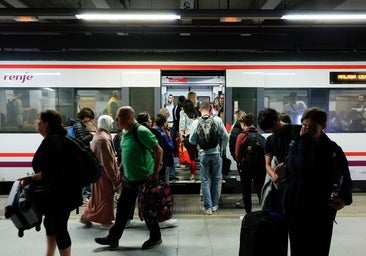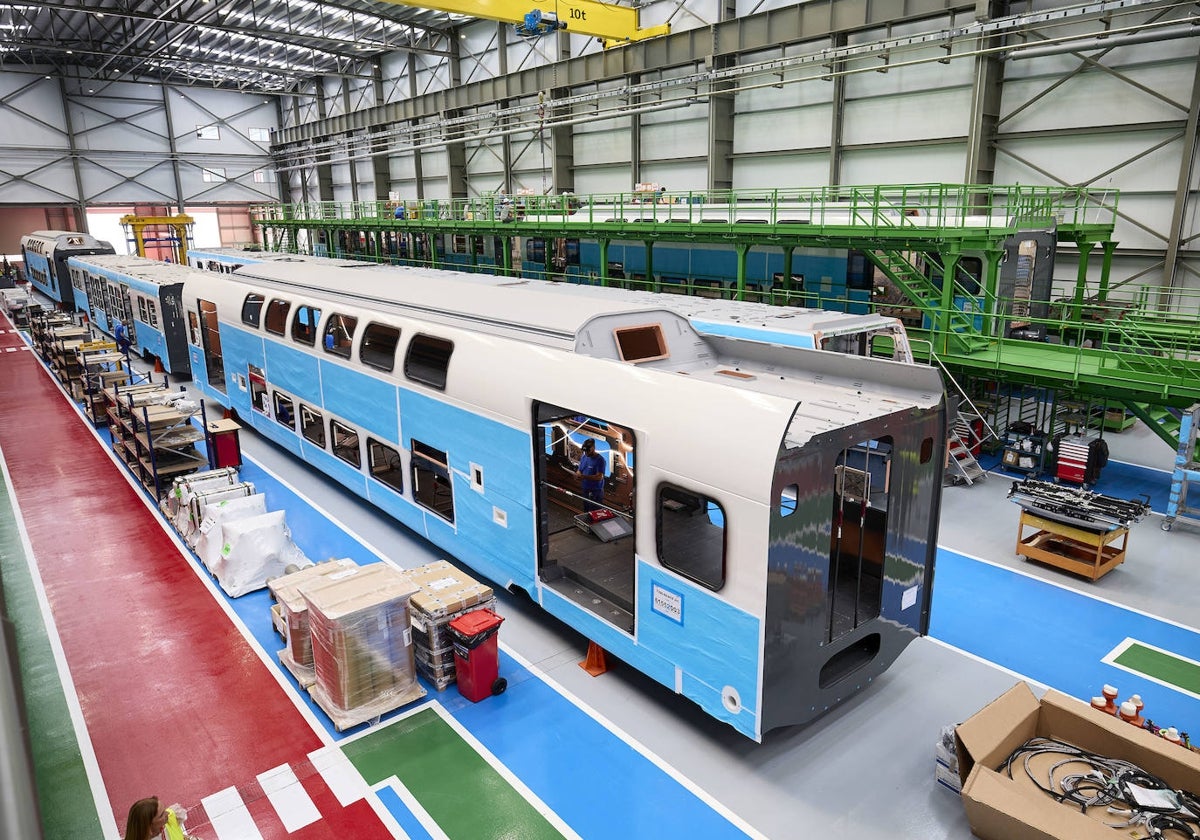'Double-decker' trains are considered to boost capacity on existing Costa del Sol railway line
The C1 Cercanías service between Malaga city centre and Fuengirola is one the most profitable passenger routes in Spain, but it regularly suffers from overcrowding problems
Rail transport on the Costa del Sol must be tackled as a two-pronged attack. Beyond the proposals for a coastal train running between Nerja and Algeciras, there is no doubt that there is much room for improvement in the Cercanías service between Malaga and Fuengirola, one of the most profitable lines in the country.
The latest idea on the table, which the Mayor of Malaga, Francisco de la Torre, suggested a few days ago, is to use double-height trains to increase capacity. His proposal has been answered by the Secretary of State for Transport, José Antonio Santano
"It is an option, but we don't yet have the trains that are needed, Renfe has made a historic purchase of more than 400 trains that will start arriving at the end of 2025. And among them there are double-height trains. Please have patience because this Ministry is doing its homework", the Secretary of State replied on his X profile (formerly Twitter) this weekend.
Es una opción pero se necesitan trenes que no tenemos todavía. Renfe ha hecho una compra histórica de más de 400 trenes que empezarán a llegar a finales de 2025. Y entre ellos los hay de doble altura. Paciencia porque este Ministerio esta haciendo sus deberes.
— Jose Antonio Santano (@jasantano) December 28, 2024
A few months ago, Renfe presented these new train units for large metropolitan areas of Spain. Their capacity is up to 950 passengers per service. They can be combined with single or double-decker carriages depending on demand, and do not have to be homogeneous throughout their composition. Features will include wifi and space for bicycles. The manufacturing contract is entrusted to Alstom and Stadler.
Feasibility study on the coastal train
A few days ago, on 26 December, the national Ministry of Transport put out to tender the first feasibility study for a rail corridor from Nerja to Algeciras. This is a historic step, insofar as for the first time it addresses the possibility of connecting the entire Costa del Sol in the future: the Malaga area, which is the main part, but also the Campo de Gibraltar area. Transports plans to contract an independent consultancy firm for 1.2 million euros (IVA sales tax included) for the drafting of the project. Although the execution period is 18 months
The ministry takes the current C1 line as the heart of the transport system on the Costa del Sol. «It has an important demand, as it connects the capital of Malaga with Malaga airport, fourth in the country in terms of passenger traffic, and with medium-sized towns located on the western Costa del Sol: Torremolinos, Benalmádena and Fuengirola,» the tender states. In the first decade of this century, the C1 route was divided into three different sections, but there is little room for manoeuvre left.
One of the most profitable lines
It has been precisely a year since the study carried out by ARCS for Malaga city council and the provincial Diputación authority with a proposal for a coastal train. In that document, the numbers of the current Cercanías were analysed in depth. And the comparison with other territories is not advantageous for Malaga and the Costa del Sol.
In terms of number of lines, Barcelona has 18, Madrid has 10, Valencia 6 and Seville 5. It is true that in the Catalan case other railway services are provided apart from Renfe.
If we take the length of the routes, Barcelona and its surrounding area have 462.7 kilometres; Madrid, 370 kilometres; Valencia, 323; Seville, 254, and Malaga, barely 70, making it the province in Spain with the shortest route length in relation to its population. Moreover, in kilometres per 100,000 inhabitants, Malaga's ratio is 4.07, significantly lower than Seville's 13, Valencia's 12, Barcelona's 8 and Madrid's almost 6.
In terms of population served, the figures are not in Malaga's favour either. In Madrid, 91.4% of the population is covered by Cercanías; in Barcelona, 89.8%; in Valencia, 60.4%; in Seville, 67.1%, but in Malaga, only 57.4%.
The data on daily circulations per inhabitant, this time provided by the ATUC national association of urban and metropolitan transport, is not flattering either. The C1 and C2 add up to 112 daily circulations in Malaga province, which gives an average of 6.7 circulations per 100,000 inhabitants. In this field, Madrid has 20.9 circulations; Bilbao, 23.3 services; Barcelona, 52.1; Valencia, 40.6; Asturias, 17.5 trains, and Alicante, 26.4 circulations, all in figures much higher than Malaga.
The annual passenger volume of the Malaga Cercanías core C1 line totalled 11.8 million passengers in the last pre-pandemic year. Seville had only 7.7 million passengers despite having three more lines. Valencia, with four more lines, was just 5 million passengers ahead of Malaga and added 16 million. Logically, Madrid (253 million) and Barcelona (119) lead the statistics by a long way. Last year, Malaga's Cercanías (suburban trains) shot up to more than 16 million.
Travellers and revenues
A particularly interesting chapter is that of passengers and revenue. Malaga has the highest revenue per passenger in relation to the length of the available network after Barcelona and Madrid, and is almost three times the size of Valencia and more than six times the size of Seville. The average revenue per passenger in Malaga is 33% higher than the Spanish average.
Which are the most used Cercanías stations according to the aforementioned document? By far, Málaga Centro Alameda (1.4 million passengers per year), Fuengirola (1.2 million), Málaga María Zambrano (1.1 million) and Arroyo de la Miel (1 million). At the other end of the scale are Torremuelle (173,000), Guadalhorce (147,000), Los Álamos (123,000) and Carvajal (118,000).
The ACRS report also makes it clear that Malaga is the least costly for the public coffers, as it covers 75% of its expenses.


